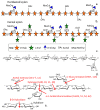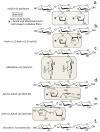Xylan Prebiotics and the Gut Microbiome Promote Health and Wellbeing: Potential Novel Roles for Pentosan Polysulfate
- PMID: 36145372
- PMCID: PMC9503530
- DOI: 10.3390/ph15091151
Xylan Prebiotics and the Gut Microbiome Promote Health and Wellbeing: Potential Novel Roles for Pentosan Polysulfate
Abstract
This narrative review highlights the complexities of the gut microbiome and health-promoting properties of prebiotic xylans metabolized by the gut microbiome. In animal husbandry, prebiotic xylans aid in the maintenance of a healthy gut microbiome. This prevents the colonization of the gut by pathogenic organisms obviating the need for dietary antibiotic supplementation, a practice which has been used to maintain animal productivity but which has led to the emergence of antibiotic resistant bacteria that are passed up the food chain to humans. Seaweed xylan-based animal foodstuffs have been developed to eliminate ruminant green-house gas emissions by gut methanogens in ruminant animals, contributing to atmospheric pollution. Biotransformation of pentosan polysulfate by the gut microbiome converts this semi-synthetic sulfated disease-modifying anti-osteoarthritic heparinoid drug to a prebiotic metabolite that promotes gut health, further extending the therapeutic profile and utility of this therapeutic molecule. Xylans are prominent dietary cereal components of the human diet which travel through the gastrointestinal tract as non-digested dietary fibre since the human genome does not contain xylanolytic enzymes. The gut microbiota however digest xylans as a food source. Xylo-oligosaccharides generated in this digestive process have prebiotic health-promoting properties. Engineered commensal probiotic bacteria also have been developed which have been engineered to produce growth factors and other bioactive factors. A xylan protein induction system controls the secretion of these compounds by the commensal bacteria which can promote gut health or, if these prebiotic compounds are transported by the vagal nervous system, may also regulate the health of linked organ systems via the gut-brain, gut-lung and gut-stomach axes. Dietary xylans are thus emerging therapeutic compounds warranting further study in novel disease prevention protocols.
Keywords: DMOAD; gut microbiome; gut symbionts; pentosan polysulfate; pre-biotics; xylan.
Conflict of interest statement
The authors have no conflict to report. M.M.S. and J.M. have both received consultancy fees from Sylvan Scientific Pty Ltd.; however, this company had no input into the design and interpretation of this manuscript.
Figures


Similar articles
-
Wood-Derived Dietary Fibers Promote Beneficial Human Gut Microbiota.mSphere. 2019 Jan 23;4(1):e00554-18. doi: 10.1128/mSphere.00554-18. mSphere. 2019. PMID: 30674645 Free PMC article.
-
Xylan alleviates dietary fiber deprivation-induced dysbiosis by selectively promoting Bifidobacterium pseudocatenulatum in pigs.Microbiome. 2021 Nov 21;9(1):227. doi: 10.1186/s40168-021-01175-x. Microbiome. 2021. PMID: 34802456 Free PMC article.
-
Prebiotic effects of diet supplemented with the cultivated red seaweed Chondrus crispus or with fructo-oligo-saccharide on host immunity, colonic microbiota and gut microbial metabolites.BMC Complement Altern Med. 2015 Aug 14;15:279. doi: 10.1186/s12906-015-0802-5. BMC Complement Altern Med. 2015. PMID: 26271359 Free PMC article.
-
The Potential of Honey as a Prebiotic Food to Re-engineer the Gut Microbiome Toward a Healthy State.Front Nutr. 2022 Jul 28;9:957932. doi: 10.3389/fnut.2022.957932. eCollection 2022. Front Nutr. 2022. PMID: 35967810 Free PMC article. Review.
-
Gut microbial utilization of xylan and its implication in gut homeostasis and metabolic response.Carbohydr Polym. 2022 Jun 15;286:119271. doi: 10.1016/j.carbpol.2022.119271. Epub 2022 Feb 23. Carbohydr Polym. 2022. PMID: 35337525 Review.
Cited by
-
Purified fibers in chemically defined synthetic diets destabilize the gut microbiome of an omnivorous insect model.Front Microbiomes. 2024;3:1477521. doi: 10.3389/frmbi.2024.1477521. Epub 2024 Dec 11. Front Microbiomes. 2024. PMID: 40114931 Free PMC article.
-
Pentosan polysulfate alleviates interstitial cystitis/bladder pain syndrome by modulating bile acid metabolism and activating the TGR5 receptor through gut microbiota regulation.Bladder (San Franc). 2025 Mar 24;12(2):e21200036. doi: 10.14440/bladder.2024.0060. eCollection 2025. Bladder (San Franc). 2025. PMID: 40747461 Free PMC article.
-
Hemp Seed-Based Foods and Processing By-Products Are Sustainable Rich Sources of Nutrients and Plant Metabolites Supporting Dietary Biodiversity, Health, and Nutritional Needs.Foods. 2025 Mar 4;14(5):875. doi: 10.3390/foods14050875. Foods. 2025. PMID: 40077578 Free PMC article.
-
Pentosan Polysulfate Affords Pleotropic Protection to Multiple Cells and Tissues.Pharmaceuticals (Basel). 2023 Mar 13;16(3):437. doi: 10.3390/ph16030437. Pharmaceuticals (Basel). 2023. PMID: 36986536 Free PMC article. Review.
-
[Pentosan polysulfate alleviates cyclophosphamide-induced interstitial cystitis/bladder pain syndrome in mice by modulating gut microbiota and bile acid metabolism].Nan Fang Yi Ke Da Xue Xue Bao. 2025 Jun 20;45(6):1270-1279. doi: 10.12122/j.issn.1673-4254.2025.06.16. Nan Fang Yi Ke Da Xue Xue Bao. 2025. PMID: 40579140 Free PMC article. Chinese.
References
-
- Forsythe P., Bienenstock J., Kunze W.A. Vagal pathways for microbiome-brain-gut axis communication. Adv. Exp. Med. Biol. 2014;817:115–133. - PubMed
-
- Gibson G., Hutkins R., Sanders M.E., Prescott S.L., Reimer R.A., Salminen S.J., Scott K., Stanton C., Swanson K.S., Cani P.D., et al. Expert consensus document: The International Scientific Association for Probiotics and Prebiotics (ISAPP) consensus statement on the definition and scope of prebiotics. Nat. Rev. Gastroenterol. Hepatol. 2017;14:491–502. doi: 10.1038/nrgastro.2017.75. - DOI - PubMed
Publication types
LinkOut - more resources
Full Text Sources

